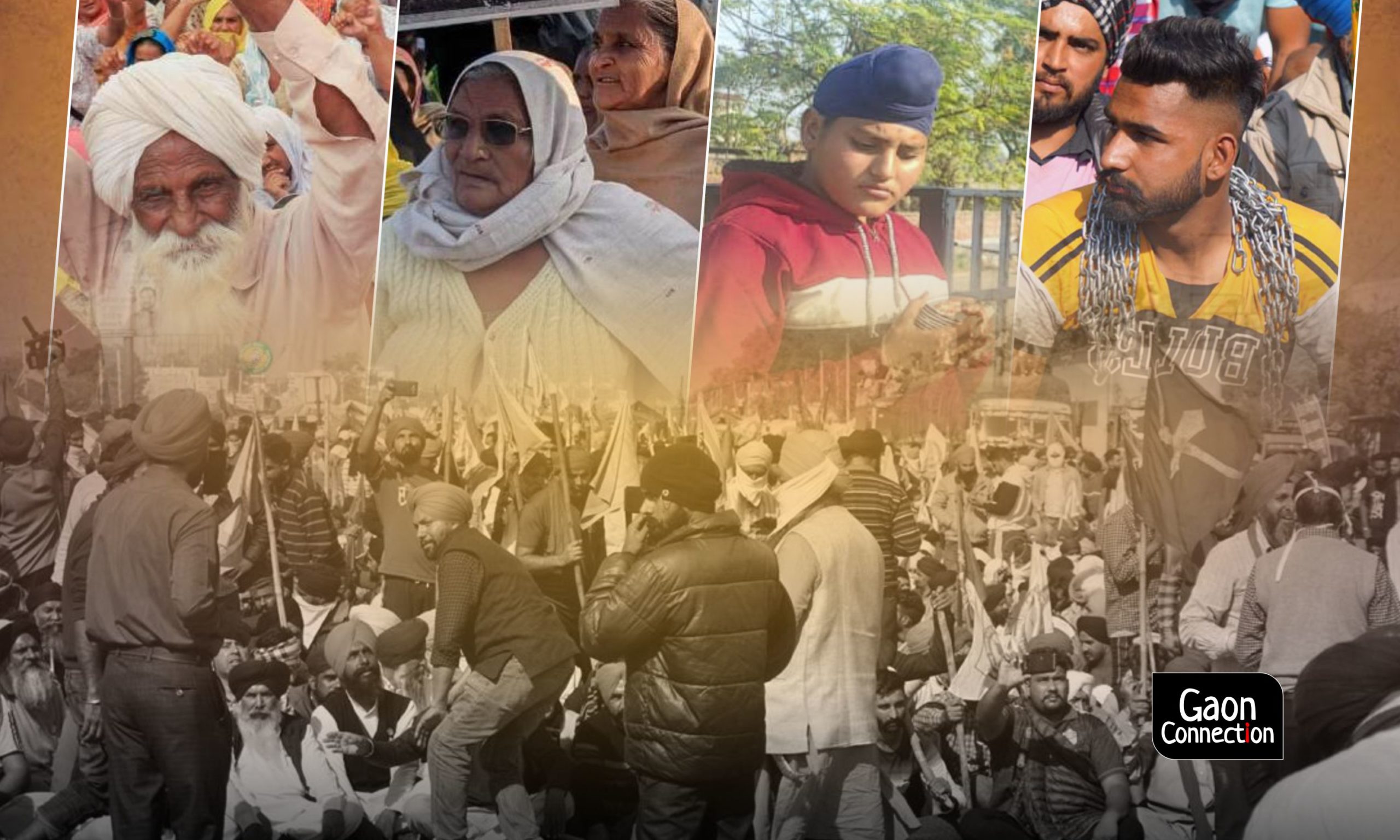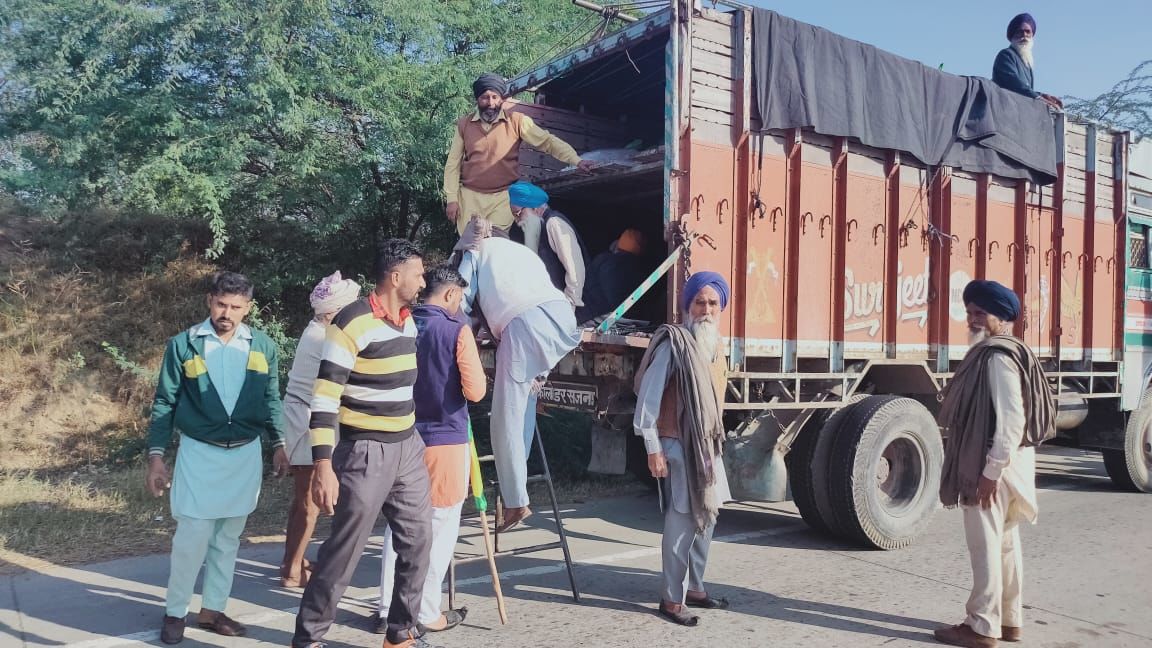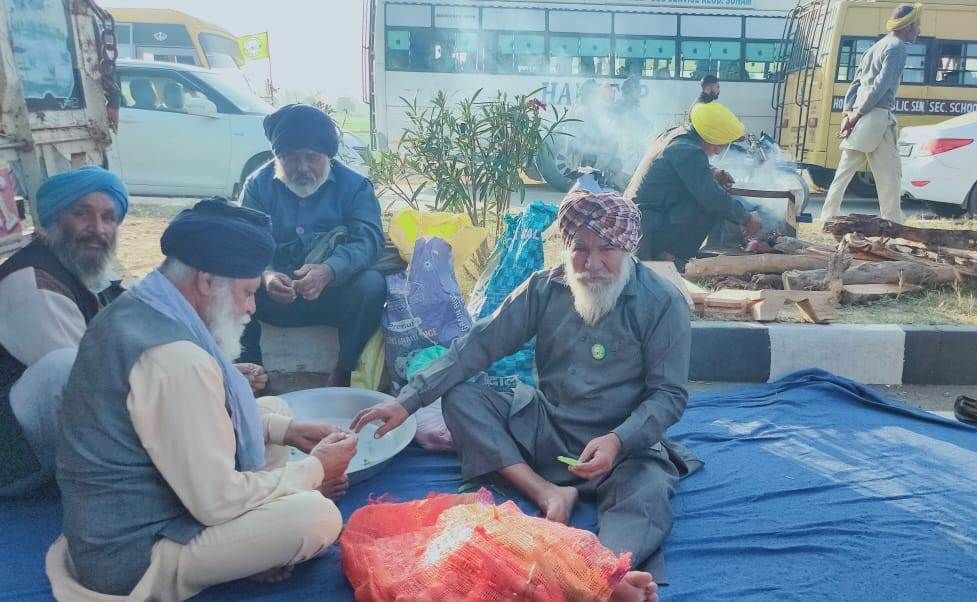Age No Bar: Neither age nor sex has dampened the energy and enthusiasm of the farmer protestors at the Dilli Chalo March
The ongoing protest at the outskirts of Delhi, by farmers of Haryana and Punjab, has brought together people across differing ideologies, political leanings and age groups to fight for a common cause - the roll back of the three agri laws.


The walking cane of an elderly farmer who was helped down from a trolley on the highway had ‘Bharatiya Kisan Union (Ugraha)’ inscribed on it. He adjusted his shawl over his shoulder and proceeded towards the gathered crowd at the Khanauri border on the Sangrur-Jind highway connecting Punjab and Haryana. Jaswinder Singh, the 70-year-old farmer from Sangrur district, had come to join the Dilli Chalo march to protest the three agri-laws. “I have come to save our land for our future generation, ” he told Gaon Connection.
Many others like him, some even older than him, had to walk the last two kilometres to Khanauri as their vehicles could not proceed any further thanks to a traffic jam.

“Four generations of my own family are involved in this movement,” Kiranjit Kaur Juneer, a social worker who works with farmer and labourer suicides in Punjab, told Gaon Connection. “For the first time, a farmers’ movement has included women and people from all age groups. They may not know much about the three agricultural laws, but they do know that these laws will not do them any good,” she added. “We have with us rations for six months,” she said. “This is a movement which transcends caste and religious divides and brings together farmers, youth, children and women,” Juneer added. All those who could not make it to the protest march, especially the women, pledged to look after the homes and fields of the farmers in their absence at the villages. “Our whole family is going to Delhi, but the farming activity will be taken care of back home,” Malkeet Kaur, a 65-year-old assured Gaon Connection.
All in it together
Likening the crisis to a family crisis where every family member helped out, Harjit Singh of Salauri district in Ludhiana, Punjab said, “When we decided to set out for Delhi, the elders asked to be a part of the agitation too. They said they wanted to spend the last few years of their life in saving the life of the next generation,” Harjit Singh explained. “Then, our women folk. So we are all in it together,” he laughed.

On November 26, it looked like all of Punjab had congregated on the borders of the national capital Delhi to force the Central government to pay heed to their grievances about the new agricultural laws. While the government saw laws as progressive and reformative, the protesting farmers looked on them as being detrimental to their future. There were protests in Punjab since September 23 when the laws came into being, with a rail roko agitation being launched on October 1 that went on till November 23.
At many places, waves of farmers began arriving and despite police and other security forces trying to prevent them from moving towards Delhi, the protestors managed to reach the capital’s borders in their thousands.
“We are landowners, farming is our life,” Gurcharan Singh, a farmer from Gurdaspur, told Gaon Connection. “Our fathers bestowed the land to us, and we will leave it to our children and so it will pass on to the future generations. However, these dark laws threaten to snatch our land away and give it over to the Ambanis and the Adanis. So we have come here to protect our land,” Gurcharan said.

On their way to Delhi, the farmers from Punjab and Haryana had to cross as many as four to eight borders defying the police, breaking the barriers and enduring water cannons, tear gas and lathicharge.
Punjab and Haryana have seen the maximum protest against the agricultural laws. Between October 3 and October 9 this year, Gaon Connection conducted a rapid survey in 16 states on the Indian farmers’ perception of the new agri-laws. The survey was conducted among 5,022 farmers across 16 states of the country. The face-to-face survey sought the farmers’ response to various central government and state government policies, chiefly, the agricultural laws, open markets, one nation one market, mandi system, MSP, impact of agriculture ordinances, their apprehensions, income from agriculture, etc.
Soon after the survey, farmers’ organisations across the country, including 31 agricultural unions in Punjab, called for the Dilli Chalo march on November 26-27 under the leadership of Samyukt Kisan Morcha. In view of the raging pandemic the government had advised the farmers against the march and asked for negotiations, but the farmers entered Delhi without any permission amid section 144 and set up camp on various points bordering Delhi.

The young and the old
The protest zones saw a lot of the elderly, constantly advising and counselling their younger farmer brethren, and helping out in the langars, while the younger generation updated information and status of the agitation on social media.
At the Singhu border, from one of the parked trolleys, Manpreet Singh and his companions posted photos and videos related to the agitation from their mobile phones and laptops. “Whatever goes on at the Singhu border, we post it on social media so that our people back at home in the villages are aware,” Manpreet told Gaon Connection. They also scotch false news reports and rumours. “It is our job to provide the true picture of what is happening here,” he said.
“The very spirit of brotherhood and unity with which people of Punjab used to live together helping each other, has resurfaced after a long gap,” Kiranjit Kaur told Gaon Connection. She harked back to the year 1783 when Sikh troops marched to Delhi against the Mughal emperor Shah Alam the Second. “After 237 years, Punjab leads another major march to Delhi,” she said. “The agitation has gathered tremendous strength by participation of millions of farmers, young and old, women and children. For many years, the people of Punjab had been divided under various political parties. Leadership was lost among the people, but they have reclaimed it due to the agitation,” Kiranjit observed.
“The government has to take back its laws,” said 65-year-old Amarjeet Kaur, one of the agitators from Mansa district. She said many others like her had locked up their homes in the villages and brought along their children. “We will not return to Punjab unless the government withdraws these three laws. How will we survive if the little land we own is taken away from us,” she asked. “Our children are not so educated that they may get jobs. We live upon the income we get by working in the fields,” she added.
There is a reason why so many generations of farmers are in the protest, said Seema Kulkarni, member of Mahila Kisan Adhikar Manch, a women farmers’ rights forum. “The livelihood of the people of Punjab and Haryana is based on farming, and this is one reason why the women have thrown their weight behind the protest,” she said. They have even gone door to door gathering rations to send to the protestors, she added.
With inputs from Neetu Singh, Daya Sagar from Lucknow, Amit Pandey from Delhi.

